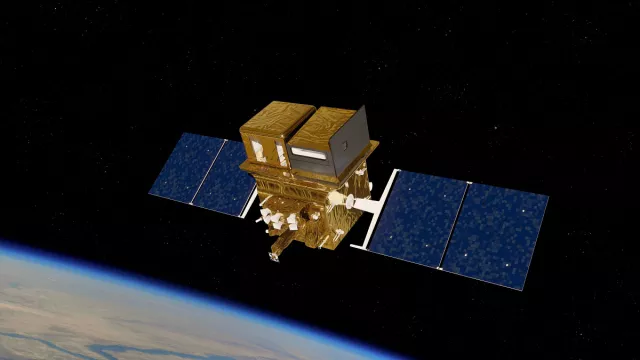Trishna is a French-Indian mission to acquire imagery of Earth’s surface in the visible and thermal infrared with a resolution and revisit frequency never seen before. The satellite is scheduled to launch in 2026.
Key information
| Mission | Measure surface temperature of land surfaces and coastal strips at high resolution and frequent revisit intervals |
|---|---|
| Domain | Earth observation |
| Launch date | 2026 |
| Partners | ISRO |
| Where | 761-km Sun-synchronous orbit, local crossing time (descending node) 12:30 p.m. |
| Lifetime | 5 years |
| Status | In development |
Key figures
- +/- 34° satellite field of view
- 3 days between observations of same point at the equator
- 57-to-90 m camera resolution; 60-m product resolution
- 2 instruments
Key milestones
- 2027: Start of operational phase
- 2026: Scheduled launch of Trishna
- 2026: Delivery of instrument to India
- March 2025: TIR instrument Detailed Design Review
- Autumn 2024: System Interface Performance and Validation Review Part #2
- November 2023: System Interface Performance and Validation Review Part #1
- February 2023: Preliminary definition key point meeting for French mission ground segment
- May 2022: System Preliminary Definition Review
- June 2021: TIR instrument Preliminary Definition Review
- 4 June 2020: Start of TIR instrument development by Airbus
- October 2019: Mission Requirements Preliminary Definition Review in India
Project in brief
Developed by CNES and its Indian counterpart ISRO (Indian Space Research Organisation), the Trishna mission is designed to observe Earth’s surface in the thermal infrared. Temperature is an indicator of the energy budget of all kinds of land surfaces, like croplands, pastures and forests, urban areas or snow and ice. This budget yields a wealth of information such as plant water stress and evapotranspiration.
For water surfaces, time-series of satellite temperature images are dynamic indicators of the structures involved in mixing the waters of lakes, rivers, their estuaries and the oceans.
Today, temperature measurements at field-level resolution from space can only be obtained monthly, and are only available at a resolution of one kilometre at more frequent intervals (from geostationary satellites).
The goal of Trishna—for Thermal infraRed Imaging Satellite for High-resolution Natural resource Assessment—is to resolve this dilemma and reach a resolution better than 60 metres with revisits several times a week. Such detailed spatial and temporal resolution will enable scientists to understand the local evolution of biological (water stress, transpiration), physical (evaporation, sublimation, plumes) and climatic (global observation over time) phenomena in relation to the water cycle.
Ultimately, Trishna will be a precious aid to inform policy decisions for farming, water resource management, land planning and much more besides.
Trishna will for the first time ever deliver precise measurements of surface temperature from all over the globe, more often and in finer detail, thus enhancing our ability to adjust irrigation more closely to plants’ actual needs. This will be key to making irrigation more efficient and bringing our water consumption under control. Trishna is therefore set to be vital in informing efforts to foster sustainable farming.
Trishna’s thermal infrared instrument, developed by CNES, will be supplemented by an optical sensor supplied by ISRO. Observing simultaneously in the visible and thermal portions of the spectrum will make it easier to juxtapose data for analysis in several fields of investigation:
- ecosystem water stress and water resource management
- hydrology of coastal strips and land surfaces
- monitoring of urban ecosystems
- cryosphere
- solid Earth
- atmosphere
CNES’s role
Trishna is being developed jointly by CNES and ISRO.
Contacts
Trishna Project Leader
Thierry Carlier
E-mail: thierry.carlier at cnes.fr
Project Science Lead (CNES/CESBIO)
Philippe Gamet
E-mail: philippe.gamet at cnes.fr
Trishna System Manager
Corinne Salcedo
E-mail: corinne.salcedo at cnes.fr
Continental Biosphere subject matter expert
Philippe Maisongrande
E-mail: philippe.maisongrande at cnes.fr


